Cybersecurity Challenges for Major IT Organizations in 2025
In an increasingly digitized world, cybersecurity remains a top priority for IT organizations.
As we step into 2025, the cyber threat landscape is evolving faster than ever, posing unprecedented challenges for major IT firms. Let’s explore some of the most pressing cybersecurity challenges organizations must prepare for in the coming year.
1. Rising Sophistication of Cyber Attacks
Cybercriminals are leveraging advanced technologies such as artificial intelligence (AI) and machine learning (ML) to launch highly targeted and complex attacks. Techniques like AI-driven phishing, polymorphic malware, and deepfake impersonation are becoming more common, making traditional security measures insufficient.
2. Increased Threat to Cloud Environments
With the ongoing migration to cloud infrastructures, the attack surface has expanded significantly. Misconfigured cloud settings, inadequate access controls, and supply chain vulnerabilities are some of the critical issues IT organizations must address. Multi-cloud and hybrid cloud environments further complicate securing data and ensuring compliance.
3. Remote Work Security Gaps
While remote work has become the norm, it continues to introduce security vulnerabilities. Employees accessing corporate networks from unsecured personal devices or public Wi-Fi networks are prime targets for cyberattacks. Endpoint security and robust virtual private networks (VPNs) are critical but often overlooked aspects of remote work setups.
4. Regulatory Compliance Complexities
As global data privacy regulations evolve, staying compliant is becoming increasingly challenging. In 2025, IT organizations must navigate a web of laws such as GDPR, CCPA, and other regional frameworks. Non-compliance not only leads to hefty fines but also damages an organization’s reputation.
5. Cybersecurity Talent Shortage
The demand for skilled cybersecurity professionals continues to outpace supply. This talent gap leaves organizations vulnerable as they struggle to build and maintain effective security teams. Upskilling existing staff and leveraging managed security service providers (MSSPs) can help mitigate this challenge.
6. Proliferation of IoT Devices
The Internet of Things (IoT) ecosystem is expanding rapidly, with billions of connected devices in use globally. Each IoT device represents a potential entry point for attackers. Securing IoT devices and networks is critical but remains a daunting task due to varying standards and protocols.
7. Zero-Day Vulnerabilities and Patch Management
The discovery of zero-day vulnerabilities continues to pose a significant threat. Cybercriminals exploit these weaknesses before organizations can develop and deploy patches. A proactive approach to vulnerability management and real-time threat intelligence is crucial to minimize risk.
8. Supply Chain Attacks
Supply chain attacks, where adversaries target third-party vendors to compromise larger organizations, are becoming more frequent and damaging. Establishing stringent vendor risk management practices and continuously monitoring third-party integrations are essential steps for mitigating this risk.
9. Ransomware Evolution
Ransomware attacks have grown in scale and sophistication, with attackers demanding higher ransoms and employing double extortion tactics. Organizations must invest in robust backup strategies, endpoint detection, and incident response plans to combat ransomware effectively.
10. AI-Powered Defensive Measures
While AI poses a threat in the hands of attackers, it also offers opportunities for defense. However, integrating AI-driven cybersecurity solutions comes with challenges, including high costs, data biases, and a steep learning curve for existing teams. Striking the right balance between human expertise and AI capabilities is key.
Strategies for Tackling Cybersecurity Challenges
Adopt a Zero Trust Architecture: Implementing zero trust principles ensures that no user or device is trusted by default, reducing the risk of unauthorized access.
Invest in Continuous Security Awareness Training: Educating employees about the latest threats and safe practices is essential to mitigate human error, which remains a leading cause of breaches.
Enhance Incident Response Capabilities: Regularly testing and updating incident response plans helps organizations respond swiftly and effectively to potential breaches.
Leverage Threat Intelligence: Real-time insights into emerging threats enable proactive defense measures.
Collaborate Across the Industry: Sharing threat intelligence and best practices within the industry can help organizations stay ahead of adversaries.
Conclusion
As we navigate 2025, cybersecurity challenges will demand a proactive, multi-layered approach. Major IT organizations must not only stay ahead of evolving threats but also foster a culture of resilience and innovation. By addressing these challenges head-on, they can safeguard their assets, protect their customers, and maintain trust in an increasingly interconnected world.








